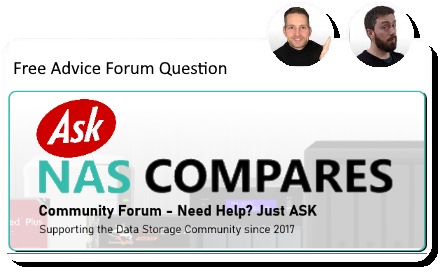Posts: 1,076
Threads: 1,077
Joined: Feb 2020
Reputation:
2
Watched your videos comparing the DS923+ vs TS-464 and was wondering if either one would have the advantage specifically for Apple Users? I am looking to auto backup photos from iPhone, iPad and Macs as well as be able to view from said devices on the go. Likewise I want to do TimeMachine backups with the possibility of also backing up to a cloud solution for redundancy. I will also use this as an SMB to record IPTV streams from Tivimate. As a final though I have an existing Drobo 5N that I am migrating from and loved their hybrid RAID solution that allowed me to use different sized hard drives. Thoughts?
Posts: 5,362
Threads: 2
Joined: Jun 2022
Reputation:
35
Thanks for reaching out, and I’m glad you found the videos useful!
When it comes to Apple integration, both QNAP and Synology have some strong points, but Synology might have the slight edge for Apple users, particularly in terms of seamless backups and ease of use.
Photo and TimeMachine Backups:
Synology's Synology Photos app works well for auto-backup of iPhone, iPad, and Mac photos and videos, making it a straightforward solution for managing and accessing your media from anywhere. On top of that, Synology handles TimeMachine backups natively, so your Mac backups will be simple to set up and manage.
That being said, QNAP can also handle TimeMachine and photo backups via Qfile and QuMagie, but Synology's user interface is generally considered more intuitive, especially for those used to Apple’s ecosystem.
Remote Access:
Both Synology and QNAP offer remote access options. Synology's QuickConnect tends to be more straightforward to set up, while QNAP’s myQNAPcloud is more feature-packed but may require a little more effort in configuration. If you're looking for simplicity on the go, Synology might be the better choice here as well.
Hybrid RAID:
For RAID, if you enjoyed Drobo's hybrid RAID, you’ll love Synology's SHR (Synology Hybrid RAID). It offers the same flexibility in mixing different-sized hard drives while maximizing your storage space. QNAP doesn’t offer a direct equivalent to SHR, though they do have their Qtier storage, which dynamically tiers storage between SSDs and HDDs, but it’s not the same as mixing drives for RAID.
SMB and IPTV Recording:
For SMB and IPTV recording, both NAS systems will handle the task well. QNAP may have an edge here with its more powerful hardware for some models, such as the TS-464, which can handle tasks like video encoding and streams more efficiently thanks to its quad-core processor.
Cloud Backup:
Both QNAP and Synology support cloud backup for redundancy—Synology with Hyper Backup and QNAP with Hybrid Backup Sync. Both can integrate with popular cloud services like Google Drive, Dropbox, or OneDrive, and QNAP also has more advanced options for multi-cloud sync, which might be appealing if you need more versatility.
Final Thoughts:
If ease of use and seamless Apple integration (photos, TimeMachine, QuickConnect) are top priorities, Synology DS923+ is probably the better fit, especially with SHR.
If you're more focused on hardware performance and future expandability (like Plex and heavier video workloads), QNAP TS-464 might be the better option.
In terms of capacity, either NAS can handle your 8-16TB needs with no issue, but keep in mind future expandability. Synology's 923+ allows for some expansion, but QNAP tends to have more scalable options.
Posts: 1
Threads: 0
Joined: May 2025
Reputation:
0
How about Spotlight support?
A NAS will contain many files in most situations. Certainly in workgroup situations.
And searching/finding files quickly seems an important task in such environments...
Does anyone has any experience on this point?





